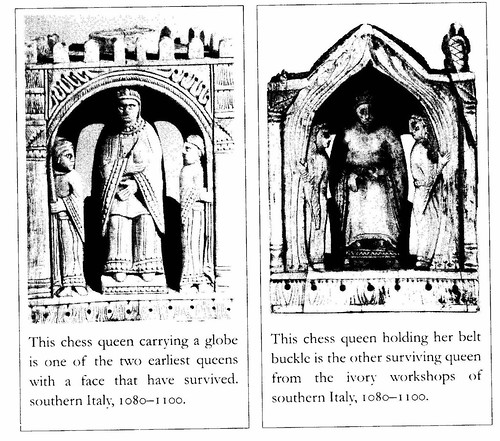Salute the queen
Luckily, most of the sales of review copies of books held in newspaper offices (which raise money for charity) are held at lunchtime, when I'm not there, otherwise I'd have already had to move out of home to make space for the bookshelves.
But I was reminded of what I'm missing by a rare sale I managed to get to, where I bought (along with lots of other books), Birth of the Chess Queen: A History, by Marilyn Yalow, 2004, Pandora.
It explains that when chess was invented in India, then transplanted into the Muslim world (where non-figurative pieces were used because of Islamic iconoclasm), and finally arrived in Europe with the Moors, the piece that stood beside the King was the vizier.
The first chess queen recorded appears in a manuscript written in the late 990s in the Einsiedeln Monastery in Switzerland. The monk who wrote it was German-speaking, although of course he was working in Latin. He makes no particular remark about her presence, so the piece was obviously well established. (p. 17)
A pawn, as today, could become a queen by getting to the other end of the board, but only if the original queen had been taken.
"...an attempt to preserve the uniqueness of the king's wife, his only permissible conjugal mate, according to Christian doctrine.... The idea of multiple queens on the chessboard proved so anxiety-making for Europeans that it remained a subject of contention for centuries to come". (p. 18)
The author seeks to find a unique model for the chess queen, proposing either Adelaide of Germany, queen to Otto I, "a second Charlemagne", or her daughter-in-law, Theosophano, the Byzantine princess, queen to Otto II and mother and regent to Otto III.
This I'd suggest is problematic - perhaps one sycophantic courtier might have had the idea of commissioning a set featuring a single powerful queen, but the idea would sure have not caught on broadly, with chess seen as a model for courtly life, unless queens in general were significant "players" in politics and war.
Yalow indeed makes this point, saying: "for a brief period in the 980s, the rule of queens regent was dominant in Western Europe. Not only were Adelaide and Theophano regents for Otto III, but Adelaide's daughter Emma was regent for the French King Louis V, the duchess Beatrice of Lorraine ruled for her minor son, and the youthful Aethelred II in England was under his mother's tutelage." (p. 26.) It is surely no accident that about this time the chess piece appeared.
It's "funny" how little focus gets put on such periods of history.
P.S. This is an interesting read, but irritating when the academic writer makes patronising attempts to cater to an "ordinary" audience. Reaching them surely does not require the profuse use of exclamation marks!








1 Comments:
"funny" is a polite way of putting it...
I'd been thinking about picking up this book. Must put it back on my list.
Post a Comment
<< Home